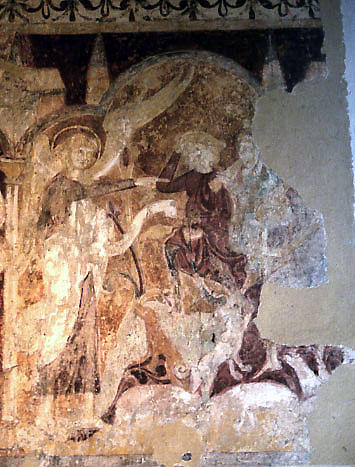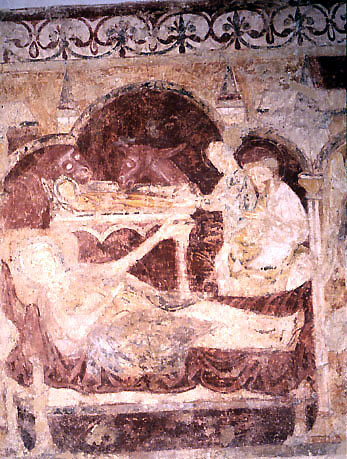Ashampstead, Berkshire (†Oxford) c.1250
Annunciation to the Shepherds/Nativity

These paintings are part of a high-quality Life of the Virgin/Infancy Cycle at Ashampstead. At the right is the Annunciation to the Shepherds, where the painter’s stylistic flair can be seen in the dramatically unfurling wing of the angel. He points with his right arm and hand at the group of shepherds further right, and what looks like the end of a girdle floating out from him at waist level might be a speech-scroll once bearing the words of his salutation.
There are three shepherds; one, nearest the Angel and wearing a dark red robe, has his hand to his hat. A second, behind and partly obscured by him, plays the pipes, the instrument crossing the first shepherd’s left shoulder. The head and most of the torso of a third shepherd at the far right have gone, but his leg, foot and the staff he leans on can be made out. In the centre of the scene are two small dogs; one, painted in red, looks towards the angel while another, in whitish pigment and with a curly tail, is shown in the same attitude but facing away, towards the third shepherd.

To the right of this scene and shown here at the left, is an equally accomplished Nativity. Mary lies horizontally across the picture space, on a bed or couch with elegantly swagged draperies. She stretches out a hand towards Joseph, who is the larger figure seated above at the right. Beside him is a smaller figure, in all likelihood Salome, the Believing midwife who did not question Mary’s virginity. Both she and Joseph have haloes and Joseph also has a round hat.
To the left is a manger holding the Christ Child lying in it while the Ox at the left and the Ass at the right feed. This is of surprisingly elaborate design, but although naturalism is seldom in any case the medieval painter’s first concern in Nativity scenes, what really matters here is that the manger and the Child are suitably raised, and can be seen clearly without being obscured by the Virgin and her bed. Nativity scenes showing the Virgin in bed are not common, but there is one other on the site, at Wissington in Suffolk.
EW Tristram pointed out that the church at Ashampstead stood a mere two miles from the manor of Aldworth, which was largely the property of the king.¹ Additionally, there were Benedictine connections in the shape of a cell of Évreux in Normandy, so the possibility that a religious house, or even the King himself, supervised or financially supported the work at Ashampstead is a tantalising one. Certainly it would account for their quality in a small and fairly remote rural parish church.
The Annunciation and Visitation are now also on the site, completing the Cycle. The later Doom has been here for some time.
Website for St Clement’s, Ashampstead
¹ Tristram II, pp.228-229